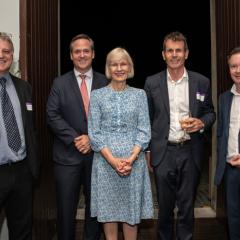In mid-October, the Queensland Government’s Department of Natural Resources and Mines (DNRM) organised groundwater workshops in five different locations in the gas fields development regions (Injune, Wallumbilla, Taroom, Noonga and Wandoan). Both landholders and coal seam gas industry representatives attended the workshops and subsequent discussions and networking.
Professor Jim Underschultz, Chair in Water, from the UQ Centre for Coal Seam Gas (CCSG) presented some of the recent research on groundwater resources within these three topics (note that the last topic on Carbon Capture Storage is not related to CCSG work, but wider UQ research that Professor Underschutlz is involved in):
GAB flow systems, 1980’s and today’s understanding compared
Our current understanding today of the GAB has the benefit of substantially more data (landholder monitoring, government monitoring, industry monitoring, and new exploration and production oil and gas wells). We see that recharge may not be not as generally effective as once thought.
It seems that much of the recharge into the high topography outcrop areas of the Hutton and Precipice Sandstones (NE Surat Basin) likely discharges into the local low topography of the Dawson River. This defines flow systems directed to the NE in this particular area rather than to the SW into the regional GAB as was the view in the 1980s.
Current “hot off the press” UQ research
Some current, yet to be peer reviewed, research with interesting promise is looking at water level patterns, hydrochemistry and hydrocarbon migration indicators in the Hutton and Precipice aquifers along the Moonie-Goondawindi fault system.
Initial indicators are that there could be localised areas of fault segments with a specific orientation that provide localised communication between the Precipice and Hutton Aquifers. This is being checked by UQ and CSIRO researchers independently on multiple data sets to either confirm or refute this current hypothesis. Any progress on this topic will be made available on this website.
Setting the scene for why people are discussing Carbon Capture Storage (CCS)
We need to examine the choices and trade-offs if this technology is considered at commercial scale in the future as one contribution towards limiting the human contribution towards climate change.
Within about 250 km of the town of Moonie, around 26 million tonnes of CO2 are emitted each year by coal fired power stations and around 3 million tonnes per year by gas fired power stations. Most of these power stations will probably not be retired until after 2040. Society needs the power but not the CO2, so a key question is: “Can we avoid CO2 emissions to atmosphere?”.
All five workshops also included an introduction to the local area 'Annual Status Report' comparing monitoring data sourced from landholders, departmental loggers and CSG companies as well as presentations by resource company hydrogeologists.
If you are interested in more information, please contact Professor Underschultz at j.underschultz@uq.edu.au.
For more information on DNRM and groundwater monitoring, visit their website.



